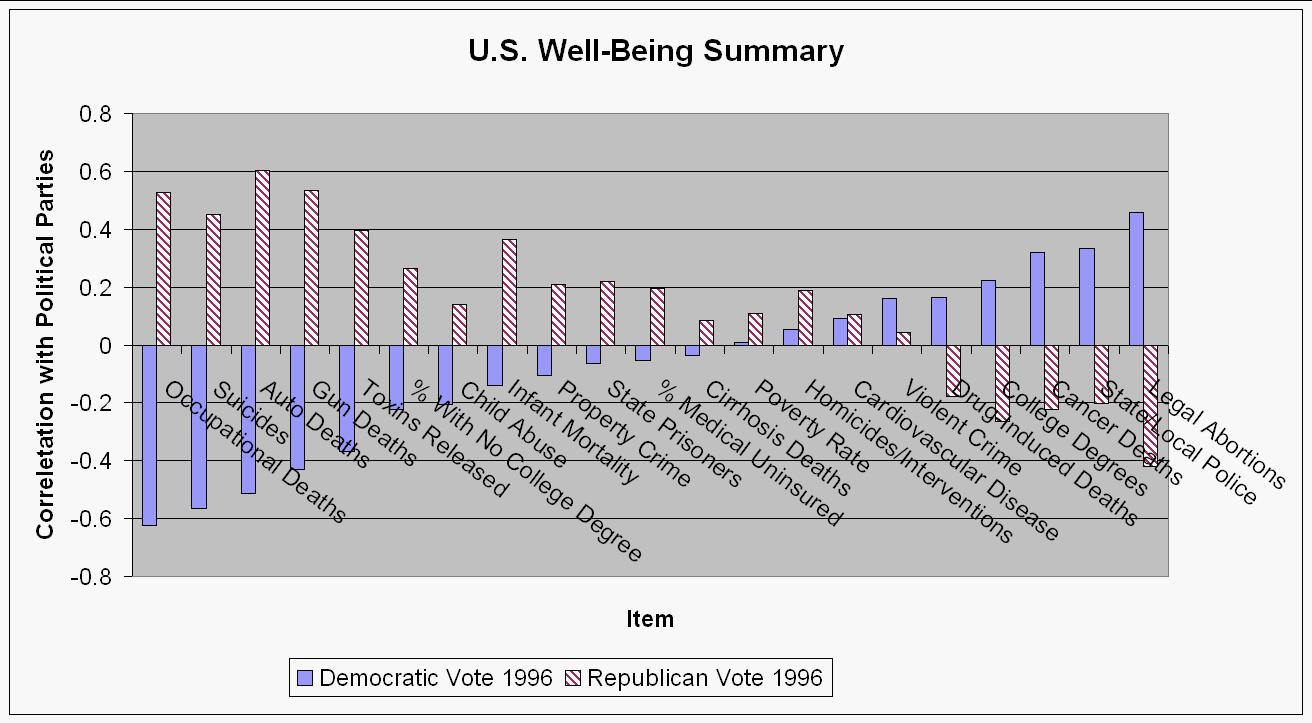
(Back to
Politics)
(Back to Economy and Political
Parties)
(Go to data table at bottom.)
There are many factors that describe the well-being of a populace. Some of them relate to physical health, including mental health, and some relate to social health, including economic health.
This is a study of the correlations between various such factors and the two major political parties in the United States (Democrat and Republican). The question being asked is: Does one of the two major political parties in the United Staes correlate better with these health factors than the other? If so, then one can conclude that some of the conditions that favor the factor in question likely favor the highly-correlated political party being in power.
To make the study manageable one year is considered: the year of the 1996 presidential election (For the voting data see: http://clerkweb.house.gov/elections/1996/TABLE.HTM). The health-factors data are chosen for that year or as closely to that year as possible. Correlations are calculated for the Democratic and Republican votes for each state in that election with the chosen health factor for each state.
An interesting by-product of this study is how the various well-being factors correlate with each other. See http://arts.bev.net/roperldavid/politics/CorrUSHealth.htm for the results.
For a summary of the results, go to the bottom of this page.
 |
| I think that most people would regard all of the factors as negative, except number of police per capita and number per capita with college degrees. Note how the correlations with the Democratic vote are mostly negative for the negative factors, while the correlations with the Republican vote are generally positive for the negative factors. For the two positive factors the Democratic correlations are positive and the Republican correlations are negative. |
Some possible factors that cause these correlations:
Some anomalies and their possible explanation:
(Back to
Politics)
(Back to Economy and Political
Parties)
(Go back to the top of this
page.)
| Summary of U.S. Health versus Political Parties Correlations | ||
| Item | Democratic Vote 1996 | Republican Vote 1996 |
| Occupational Deaths | -0.624 | 0.528 |
| Suicides | -0.566 | 0.452 |
| Auto Deaths | -0.512 | 0.602 |
| Gun Deaths | -0.429 | 0.533 |
| Toxins Released | -0.368 | 0.394 |
| % With No College Degree | -0.223 | 0.265 |
| Child Abuse | -0.205 | 0.14 |
| Infant Mortality | -0.14 | 0.364 |
| Property Crime | -0.107 | 0.208 |
| State Prisoners | -0.065 | 0.219 |
| % Medical Uninsured | -0.052 | 0.194 |
| Cirrhosis Deaths | -0.037 | 0.084 |
| Poverty Rate | 0.01 | 0.11 |
| Homicides/Interventions | 0.053 | 0.188 |
| Cardiovascular Disease | 0.093 | 0.104 |
| Violent Crime | 0.16 | 0.044 |
| Drug-Induced Deaths | 0.165 | -0.178 |
| College Degrees | 0.223 | -0.265 |
| Cancer Deaths | 0.319 | -0.223 |
| State/Local Police | 0.335 | -0.202 |
| Legal Abortions | 0.457 | -0.421 |
(Back to
Politics)
(Back to Economy and Political
Parties)
(Go back to the top of this
page.)